General principles of prevention and management
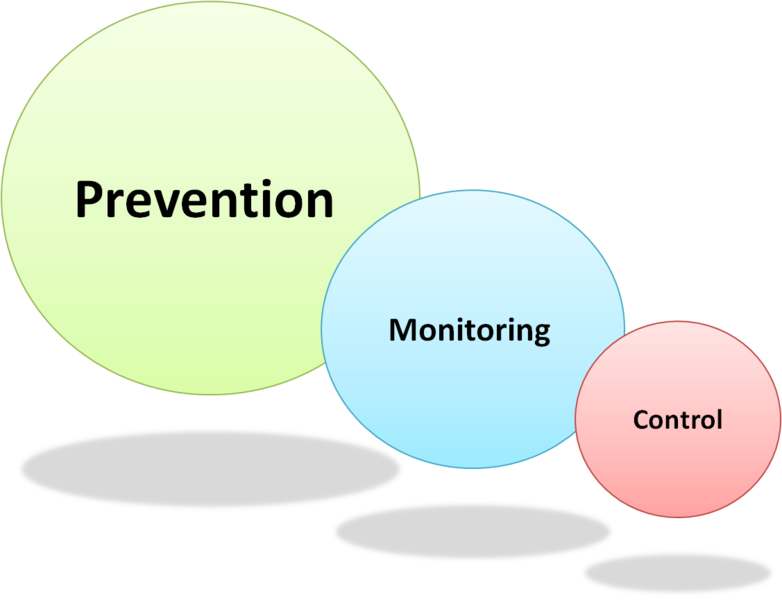
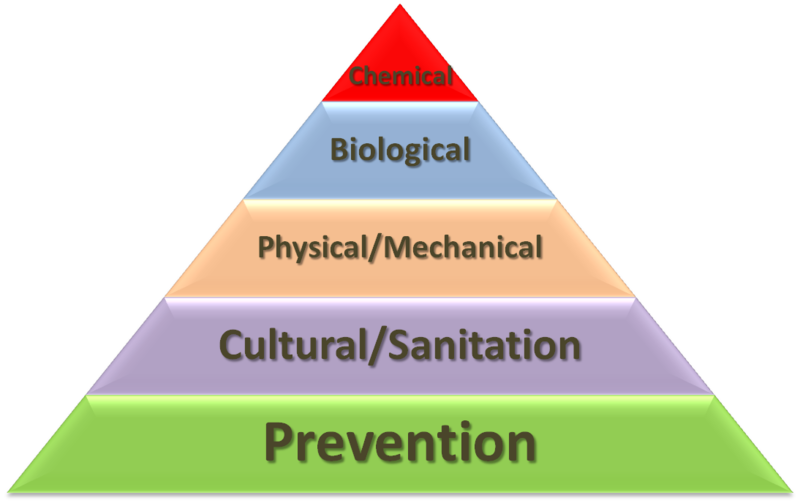
Prevention |
|
|
Houses
|
Food strorages
|
Management
Chemical pest control
- Use of chemical substances. Chemical substances should be used according to the manufacturer’s guidelines. Furthermore, all the nessecarry precautions should be taken into consiteration in order to avoid poisonings.
- Short – term results
- Harmful effects on humans and the environment.
Biological Management
- Customized to any harmful organism and its bio – ecology.
- Pest control takes place mostly using a biological control agent
Integrated Pest Management (IPM)
I. Mechanical
Dehydration (with diatomaceous earth): when in contact with any insect, in any development stage, it causes erosion of the exoskeleton resulting dehydration and eventually the insect’s death. It is a highly safe, efficient and economic pest control practice when dealing with insects, storage mites, house insects (fleas, bedbugs, ants, cockroaches) and even harmful wood infesting insects such as termites.
Pressure: a. High pressure b. compressed dry air
Drying: exposure to the sun or to an autoclave
Mechanical movement i.e sieving
Void: Total or high and continuous void
Asphyxiation: mixing seeds with oil
Washing using water
II. Natural
Heat: a hot current of air is preferred when dealing with products whereas hot water or steam is better for means of transport, tools and machinery.
Cold: Mostly on fresh fruit in order to control Diptera in their early development stages.
Electrostatic Field: i.e. a machine that electrocutes dry wood termites at 90 watts, 90,000 volts and a frequency of 100 kHz. without raising, at the same time, the temperature of the material processed
Irradiation: sterilizing products for immediate consumption by humans mostly with gamma rays and infrared radiation.
III. Tropisms - «insect-statics»
Through the use of insect-statics, we can “dilute” the density of the population of harmful insects to the point where no stored products are completely destroyed and there is no significant economic damage. Decreasing the number of insects in a certain space in order to avoid chemical treatments is what we call insecti-stasis.
Phototropism (electrical traps)
It is applied with the use of light traps and it is based on what is called positive phototropism. It is used for the collection and determination of insects moving through closed up spaces as well as for the reduction of mostly flying insects.
Pheromone Traps
Pheromones are a means of chemical communication between members of the same species. They include sex pheromones, aggregation pheromones and alarm pheromones.
IV. Chemical Methods
Insect Growth Regulators
Botanical Insecticides
Biological Pesticides
Contact Pestisides
Fumigation
V. Other Pest Control Methods
- Modified Atmosphere = changing the concentration of one or more gasses and
- Controlled Atmosphere = changing the pressure through changing the concentration of one or more gasses.
Source: www.pestpractice.eu/library.html
K. Bouchelos
Emeritus Professor
Agricultural University of Athens
Methods of prevention (1)
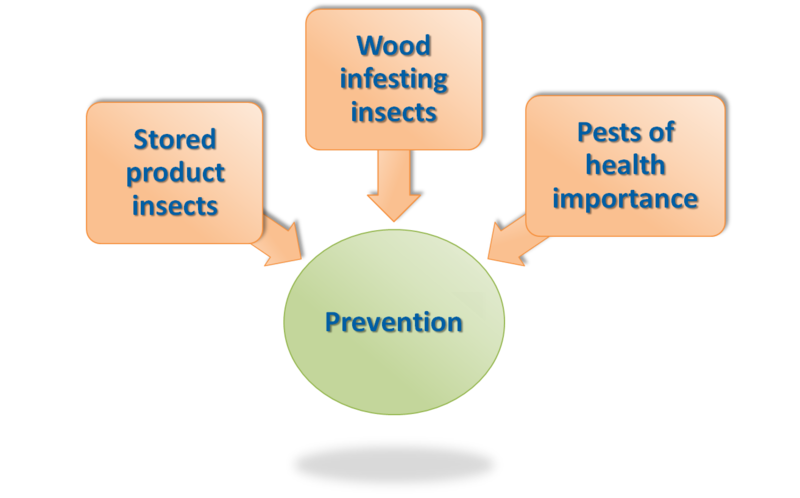
Stored products insects
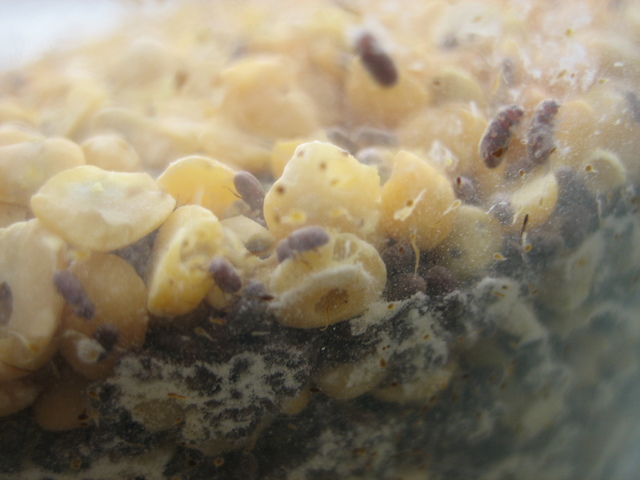
- Visual Control
- Conditions Control
- Sampling
- Use of Traps
Sampling:
- Abolute Estimation: it allows us to gather information about the number of insects contained in a specific sample size
- Comparative Estimation: it allows us to gather information about the number of insects contained in an unknown sample size. (measurements per unit of sampling attempt)
Wood – Infesting Insects
- Use of “good” quality wood – Healthy wood
- Use of oil paint or paint with other preservatives on every wooden construction
- Avoiding making any cracks on wood
- Preventive spraying of wooden constructions with pesticides which have long-term residual effects
- Avoid any humidity concentration in wooden parts of the house.
- Firewood should not be stored on the ground. Furthermore, firewood in houses should be consumed quickly
Methods of prevention (2)

Mosquitoes
Fumigation indoors- Fumigation coils
- Electrically heated mat
- Liquid Insect Repellents
- Mechanical Protection of the residence (using screens on doors and windows, mosquito nets etc.)
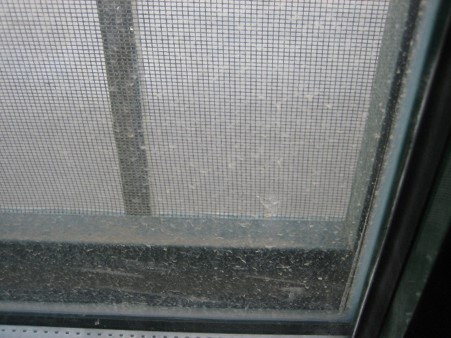
Use of repellents (emulsions, lotions aerosol, sticks, etc.)
Flies – Midges
- Estimating the problem identifying the species
- Locating the nest where the prelarval stage are located
- Hygiene and Preventive Measures
- Controlling of Larvae
- Controlling of Adults

Cockroaches
- Check all the spots – possible shelters such us cracks and openings near food or near humid and dark corners.
- Cleaning measures
- Remove any waste, food or standing water from the house.
Methods of prevention (3)

Bedbugs
Removal, Blocking- Various appliances (UV, vacuum etc)
- Removal of furniture, mattresses etc.
- Exposure of possible refuge sites – shelters to high temperatures i.e. sunlight
- Adhesive surfaces (tapes)
- Blocking the entrance into the house (clothes in bags, covering mattresses with plastic, closing up cracks with silicone etc.)
Fleas
- Controlling rodents
- Constant observation of house animals
- Cleanliness: removal of residue, feces etc. of fleas, cleaning possible refuge sites (dust, carpets etc)
- Fleas can grow even in the most clean house
Lice
- Personal protection (repellents and shampoo)
- Cleaning: Removal of lice when brushing, checking all clothing

Ticks
- Use boots
- Use repellents in boots, socks and pants.
- Avoid laying on the ground
- Pesticide application on animal vectors -
- People having contact with infected animals should always check their clothing and body for ticks.
Mites (Acari)
Based on taxa
-
Genus Sarcoptes
- Contact with Animals
-
House dust mites
- Frequent vacuuming with specialized vacuums in order to properly remove any dead mites as well as their feces
- Washing sheets and pillows with hot water – frequent cleaning, shaking and hanging them out in the sunshine. Reduction of temperature and humidity (below 20 ο C and 50 % Humidity)
- Ionizers air filters
- Medical testing for allergies
-
Chiggers
- Repellents (for socks and feet)
-
Dermanysus
- Use of insecticides on infested walls
- Repulsion of birds (i.e. pigeons)
-
Stored product mites
- Reduction of humidity inside the storage room and near any product, hygiene conditions.
Methods of management (chemical and non-chemical methods)
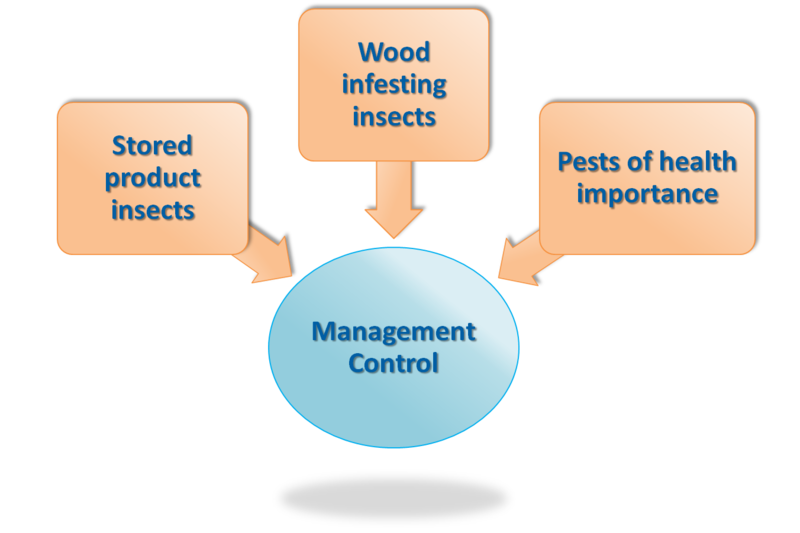
Stored product insects
-
Natural: High temperatures
Ventilation
Packaging
Mechanical destruction
ENTOLETER
- Fires flour between two steel surfaces with spikes
- It kills all insect species in all development stages
- >2900 rpm
- Biological
-
Chemical: Protectants
Fumigrants - Biotechnological
Wood Infesting Insects
- Control is difficult
- Mostly with gas insecticides, modified of controlled atmospheres.
- Not termite gas
- For termites we can apply insecticide with drilling- remove any “suspicious” material (old firewood etc).
Mosquitoes
- Management of sites they inhabit in order to breed
(Drainage, Destruction of their breeding sites even of the small ones) - Recording of potential breeding sites – mapping
- Population density leading to control measures
- Chemical control (available means –air spraying)
- Larvicidal applications (and to a lesser extent), applications agaist adults
- Personal Protection Measures
Flies
- Προνύμφες δύσκολο να εντοπιστούν
- Καταπολέμηση ενηλίκων με ψεκασμούς (όπως ενήλικων κουνουπιών)
Σκνίπες
- It is difficult to locate the larvae
- Controlling adults by spraying (i.e adult mosquitoes)
Cockroaches
- Detect and spray only spots of frequent crossings as well as the ovaries with the chosen insecticide:
- Insecticides that can be applied in various forms
- Gels (Food based Baits )
- Insecticides in dust form.
- Traps (i.e. adhesive surfaces)
- Baits (i.e. attractant substances containing pesticides)
- Explain and remind the appropriate person the importance of constant inspections, the need for hygiene in the workplace and the true meaning of waste (insects, rodents, fungi, bacteria)
Bedbugs
- Apply insecticides
- Synthetic pyrethroids, growth regulators
- foggers
- Often, apply more than once
- Resiliesnce
- Fumigation
- of spaces and materials (beds, mattresses etc)
- High temperatures
- >45 oC
- Resilient in low temperatures (they can survive for days in 0 oC)
- Apply CO2, Ν2, steam
- CO2 and Ν2 both in gas form and as dry ice
Fleas
- Synthetic pyrethroids, growth regulators, neonicotinoids etc.
- Resistance (in pyrethroids), loss of drastic contents
- Foggers
- Repellents (personal protection, mostly on animals)
- Holometabolous insects– applying insecticides against both adults and all the other development stages
Lice
- Pesticides
Ticks
- Cleaning of all areas (herbicides, disinfestations)
- Insecticides in interior and exterior spaces, on doors, on the floor and on the ground, in dog houses etc.
- The combined use of larvicides and adulticides is highly recommended.
Advantages and disadvantages of each method

Purpose: controlling harmful organisms without causing both health and environmental issues.
Chemical Methods:
- Immediate results
- Short – term results
- Resistance over time
- Attention to sensitive areas
Mechanical & Natural:
- Safe for human health
- In some cases more economic
- They do not leave behind residue on products
- Limited application
Examples
Gas Advantages
- They can spread rapidly within a space or a product and penetrate materials that other pesticides cannot (difference with aerosols)
- Instant effects on all insect development stages (even on eggs)
- Effective on a wide range of insect species, mites etc.
- No residue on products and limited residual effects.
- Application only when necessary (after the infestation is noted)
Gas Disadvantages
- Very dangerous, during the applications, if the necessary precautions are not taken.
- Resistance development from certain species
- In large storage spaces (i.e. silos) in order to apply fumigants, the relative equipment is needed.
Instant Effect Rodenticides
Advantages
- Instant Death
- All dead mice are visible
- Only a small amount is necessary
- Effective where there is resistance to anticoagulants
Disadvantages
- "bait shyness”
- High content means low attractiveness
- Dangerous to other animal species
- There is no antidote, dangerous to use
Anticoagulant Rodenticides
Advantages
- No "bait shyness"
- High content
- Low content hence more safe
- Effective antidote
Disadvantages
- High cost to apply
- A large amount is needed
- Resistance development
Differences between chemical and mechanical/natural methods.
Examples
Criteria for the selection of the most appropriate method(s)

- Understanding the bio – ecology of the pest.
- Methods that can be used at the appropriate time.
- Deciding if the infestation is serious in relation to the economic loss.
- Compare the cost and effectiveness of the various methods of control
- Plan for the future – Long – term results.
Examples
Mosquitoes

- Defining the species.
- Studying and having knowledge of the biology and ecology of a species.
- Monitoring of the population: breeding sites, monitoring the specific time of year when there is an increase in the population density etc.
- Recording the measures that can contribute to the reduction of the population density.
- Choosing a measure or a combination of measures that can be applied: achieving the best possible outcome with a measure that has the lowest risk for humans and the environment as well as the least economic cost.
- Determining the right time to act.
- Determining the appropriate body to implement any pest control activities as well as the authority that will handle the monitoring part of the process.
- Informing and and educating the public on the possibillity of contributing in the prevention and treatment of such issues.
Wood infesting insects
- Woodworms or Termites?
- When dealing with woodworms, remove the infested wood.
- Applying gas under certain conditions
- Applying thermal pest control methods
- For termites, apply liquid insecticides at the are in question based on the capability of injection on the walls etc.
Mites
- Blood feeding mites or not?
- In cases of blood feeding mites, use of a “chemical barrier” on the area under protection
- Similarly and use of a “mechanical barrier” for the same case
- Amending conditions when dealing with house dust achari (non blood eating achari)
- Removal, cleaning, reducing relative humidity.
- Using of liquid insecticides and gasses for mites found in stored agricultural products and food.
What are the basic criteria when choosing a method?
Examples of the process of choosing a method



